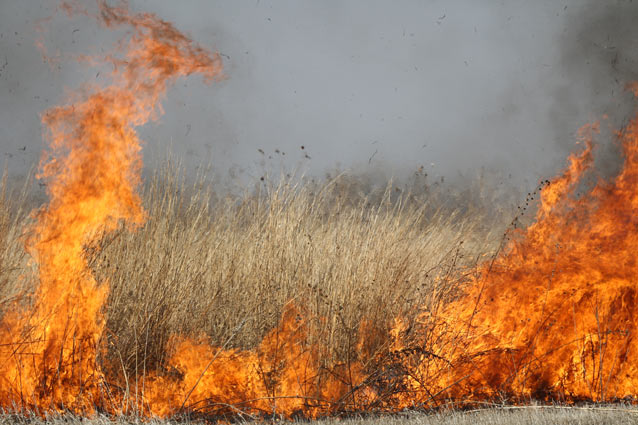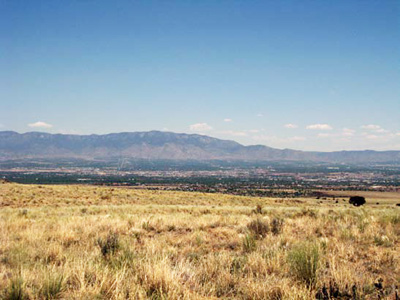Southwestern grassland and shrubland communities expand and contract in response to the frequency and intensity of natural disturbance events (Ford et al. 2004) and are also shaped by anthropogenic influences.
Natural Disturbance
Major natural disturbances in southwestern grasslands include fire, extreme climate events, and herbivory and trampling by native fauna.
Fire
In many grassland systems, fire contributes to maintaining grass dominance by preventing woody trees and shrubs from establishing. It also may facilitate nutrient cycling and accelerate decomposition rates in grassland soils. Fire regimes vary greatly within southwestern grasslands and will be discussed individually for each grassland type.
Desert grasslands and shrub-steppe
Historically, fires occurred every five to ten years in desert grasslands (Mau-Crimmins et al. 2005). The absence of fire has allowed woody plants and nonnative grasses, like Lehmann lovegrass (Eragrostis lehmanniana), to invade (Mau- Crimmins et al. 2005).
Colorado Plateau semi-desert grasslands and shrub-steppe
In the most sparsely-vegetated, semi-arid grasslands, wildfire is of limited importance as a natural disturbance. Examples of such fuel-limited grasslands can be seen in Glen Canyon National Recreation Area and Chaco Culture National Historic Park. However, wildfire can be an important natural disturbance on more productive, densely vegetated grasslands, such as those that occur at Wupatki National Monument (Miller 2005).
Southern plains grasslands
Fire is essential to maintaining the health of short-grass and mixed-grass prairie. Fire helps maintain the diversity of native species and prevents woody shrubs and trees from invading the grasslands (Perkins et al. 2006). Prior to the introduction of livestock, landscape-scale fires probably occurred every three to ten years in the southern mixed-grass prairie, and less frequently in the short-grass prairie (Umbanhowar 1996). Prescribed fire can help replicate the natural fire regime; however, since only small areas of prairie exist that are protected from development, natural resource managers cannot create the landscape-scale fires necessary to restore a full diversity of plants (Perkins et al. 2006).

FWS
Human-caused Disturbance
Anthropogenic stressors in southwestern grasslands and shrub steppe include altered fire regimes, livestock grazing, the introduction and spread of exotic invasive plants, disturbance of biological crusts, and development (urban and agricultural).
Livestock grazing
History of Cattle Ranching in the Southwest
The first cattle arrived in the Southwest in 1540 with the Spanish explorer Francisco Vasquez de Coronado. Bred in a semi-arid environment in western Spain, these cattle were well-adapted to the region's climate (Milchunas 2006). Through the 1700s, the numbers of cattle, sheep, and goats in the Southwest increased, and by 1846 signs of overgrazing began to appear near Sante Fe, the Rio Grande Valley, and the Rio Puerco watershed in New Mexico (Milchunas 2006). However, grazing generally remained a small disturbance until the cattle boom of the 1880s.
The boom began when Civil War veterans from Texas began to relocate their herds of American cattle from the overgrazed Texan rangelands into Arizona (Morrisey 1950). The completion of a railroad through Arizona and New Mexico had opened up quality grasslands and allowed for easier importing and exporting of cattle to and from the Southwest (Morrisey 1950). Cattle ranching expanded explosively, until the summer rains failed to fall during the catastrophic years of 1891 to 1893. With little grass growth, a large proportion of the livestock died and major erosion of topsoil occurred. Although overstocking of cattle continued after the drought, cattle numbers peaked in 1891 (Milchunas 2006). Grazing declined somewhat in the 1910s and 1920s as homesteading reduced the amounts of open, unfenced range and the Forest Service started to fence its land (Milchunas 2006).
In contrast to herbivory by native animals, livestock grazing can cause more extensive changes to the structure and functioning of grasslands. The response of a particular plant community to livestock grazing is largely determined by the evolutionary history of large herbivore grazing and by its above ground primary productivity (Milchunas 2006). The semi-arid and desert grasslands, with their short histories of grazing, are less tolerant of grazing than the plains grasslands. In addition, semi-arid and desert grasslands display a broader range of responses to grazing than plains grasslands (Milchunas 2006). Because grazing is more likely to decrease native plant cover in semi-arid and desert grasslands, these grasslands may become more susceptible to invasion by exotic and opportunistic native species (Milchunas 2006).
In general, livestock grazing affects overall grassland ecosystem productivity by altering vegetative cover, soil physical properties, microbial communities, carbon cycling, nitrogen fixation, erosion, and soil hydrologic properties (Schlesinger et al. 1990). Trampling by cattle causes soil compaction, decreased water infiltration, and increased surface runoff. Increased surface runoff results in an uneven spatial distribution of moisture and plant nutrients—conditions conducive to colonization by woody plants (Schlesinger et al. 1990). Selective herbivory by livestock also facilitates woody plant invasions by favoring the establishment and growth of unpalatable plant species over palatable species (Miller 2005). Livestock grazing also facilitates the conversion from native perennial grass-dominated landscapes to landscapes dominated by exotic annual grasses, such as cheatgrass.
Disturbance of Biological Soil Crusts
Colonization by invasive, exotic plants, livestock grazing, foot traffic, and motorized vehicle traffic can cause a decrease in biological soil crust cover (Belnap et al. 2001). Biological soil crusts are fragile and slow to re-establish after disturbance. Because well-established biological soil crusts tend to be darker in color than bare or disturbed soils, they absorb and retain more solar radiation (Belnap et al. 2001). Lighter soils have increased surface albedo (energy reflected off of the soil surface) and cooler soil temperatures, which decrease plant metabolic processes and seedling growth rates, delay seed germination, and interfere with surface foraging of insects and small mammals (Belnap et al. 2001). Disturbance of biological soil crusts can also increase erosion and surface runoff. Of all soil types, biological soil crusts are least vulnerable to trampling by livestock when soils are frozen or protected by snow (Belnap et al. 2001).

NPS
Development
Over the past century, urban development, agriculture, and the construction of power lines and roads have affected grassland ecosystems. Development has fragmented what were once continuous grasslands (Merola-Zwartjes 2004), altered habitat structure for wildlife, increased water and air pollution, and facilitated the introduction and spread of exotic species (Miller 2005).
Prepared by Jamie Nielson, Kelly Reeves, and Lisa Thomas, Southern Colorado Plateau Network Inventory and Monitoring Program, 2010.
Part of a series of articles titled Grasslands of the American Southwest.
Last updated: July 30, 2015
